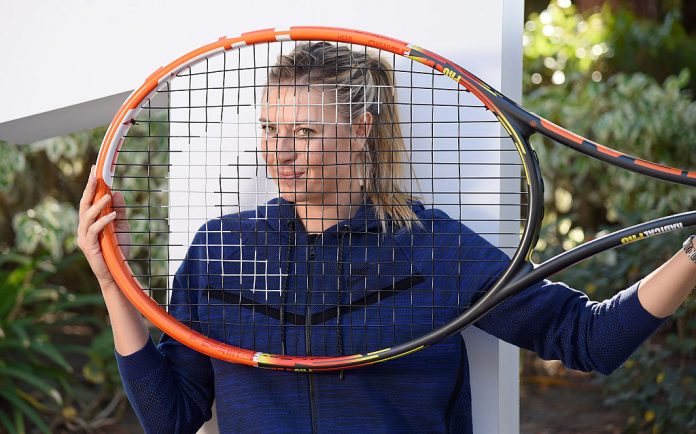A DOZEN TRENDS
1. GLOBALIZATION: Until well into the Open Era, the game’s foremost players were, with two exceptions, white. English, with a smattering of French, prevailed. Year-end tourneys were at Madison Square Garden. But tennis gradually became an important way for aspiring athletes to escape poverty and political oppression. Now the world is flat – tennis thrives across the globe. The sport has felt the “Ova-the-top” impact of Russian players. Eastern Europeans from Serbia to Latvia have excelled. Michael Chang and then Li Na brought the game to Asia, where it’s thriving.
2. FOLLOW THE MONEY: Prize money for the first US Open was $14,000. The winner of the ’17 Open earned $3.7 million. Sharapova earns about $24 million a year. Money impacts decision-making at every turn. One recent example is the 119-year old Davis Cup being discarded for a pricey, billion-dollar World Cup.
3. ALL-COURT PLAY: Three Slams used to be on grass. Now there’s just one – and Wimbledon’s grass is slow. New topspin strokes, power rackets and composite strings have transformed once imposing net charges into suicide missions.
4. FITNESS: Once Suzanne Lenglen drank cognac on changeovers and players proudly proclaimed the wonders of smoking in cigarette ads. Then Margaret Court, Martina Navratilova and Ivan Lendl started going to the gym and beefing up. Amazingly, Navratilova was actually criticized for being too bulky. What was once a virtually muscle-free sport is now an increasingly gluten-free happening. Fitness and sensible diets are essential – “Which way to the salad bar?” Physios are as important as passports. Is Federer’s trainer Pierre Paganini the most under-appreciated figure in tennis?
5. STRINGS AND RACKETS: Forget your grandfather’s Oldsmobile and his wooden racket. Metal frames of every stripe have long ruled, and hybrid power strings are the most underrated innovation of the Open Era.
6. TWO-HANDED BACKHANDS: Thanks to Bjorn Borg, Chris Evert, Jimmy Connors and Cliff Drysdale, this reliable, powerful shot now dominates. Even the man with the most beautiful one-handed backhand in the game, Mr. Federer, will be teaching his children the two-hander.
7. PROFESSIONALIZATION: Players used to be solitary nomads hustling to survive. Now swarming entourages featuring agents, coaches, hitting partners, PR spinners, physios, massage therapists, parents, spiritual advisors and handlers who manage every detail are the new normal. Many players have become brands (what’s a tennis fan without a Federer cap).
8. BIGGER PLAYERS, LONGER CAREERS: After an era of teen champs – Hingis, Graf, Seles, Capriati – new rules, conditioning, big money and professionalization led to an era of powerful elders. Roger and Serena are 36. And`players 6’5″ and above are increasingly making their mark.
9. ‘SOMBERIZATION’: The flip side of professionalization is the emergence of an unsmiling over-seriousness. Control freaks are ascendant and they stifle the creative spirit of the game. Do we really need all these clocks, warnings and micro-rules? Are these players bankers, brands or graceful, imaginative sporting wonders? God forbid an ump should smile. This should be an appealing court, not an appellate court – why so grim, good folks? France’s Yannick Noah contended, “There are too many matches where you don’t see emotions, where you don’t see the ultimate battle, man against man. There are too many rules…It is important we have boundaries, but now it is too proper…Tennis is unique, very raw. This is what we need to get back.”
10. ACADEMIES: Nick Bollettieri’s academy gathered the best players on the planet, created champions and forged a replicable model. Now it seems every coach in every village has an academy.
11. SOCIAL MEDIA: Twitter, Instagram, Tumblr – tennis has its own virtual reality. But Maria Sharapova, who has 8.1 million Twitter followers, is not a fan. She said, “One thing I’ve noticed recently, in the locker room, is how almost every player on tour has the exact same post-match habit: Walk off the court, head into the locker room, and then immediately — I mean, literally before they’ve even changed their clothes or taken a shower — grab their phone, log on to Twitter, and then search through their mentions.
“It’s something I began to notice a few years ago, and it just really struck me. Here is this … it’s like an Opinion Machine, or a Validation Machine, and everyone seems consumed by it. And who knows — maybe I’m missing out. Maybe it’s wonderful. But that’s just never been my way.”
12. PLAYER DEVELOPMENT PROGRAMS: France, Spain, Britain and the mighty US all have national programs driven to produce that most cherished of tennis commodities, a Grand Slam champion.
HONORABLE MENTION: France’s Phillipe Chatrier says a great sport has to have a great infrastructure, so he greatly upgrades Roland Garros. US Open visionary Slew Hester, Aussie Brian Tobin, Wimbledon’s John Curry, Indian Wells’ Charlie Pasarell, Miami’s Butch Buchholz and Madrid’s Ion Tiriac follow suit. Now tennis has, so to speak, great bones.



















